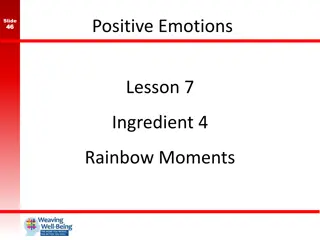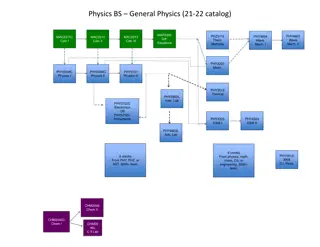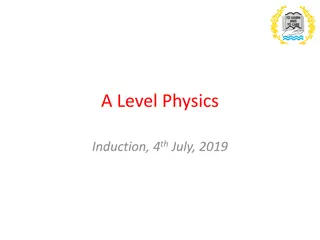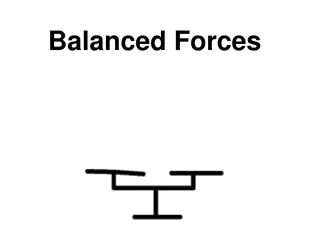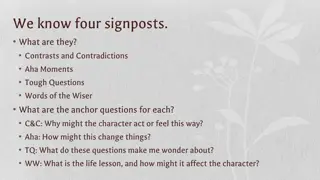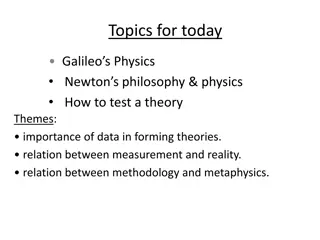Moments in Physics
Concept of moments in physics, focusing on the measurement of the turning effect of forces on objects. Learn how to calculate moments using trigonometry and solve problems involving uniform rods and beams. Discover the importance of achieving equilibrium through balancing forces and moments.
Download Presentation

Please find below an Image/Link to download the presentation.
The content on the website is provided AS IS for your information and personal use only. It may not be sold, licensed, or shared on other websites without obtaining consent from the author.If you encounter any issues during the download, it is possible that the publisher has removed the file from their server.
You are allowed to download the files provided on this website for personal or commercial use, subject to the condition that they are used lawfully. All files are the property of their respective owners.
The content on the website is provided AS IS for your information and personal use only. It may not be sold, licensed, or shared on other websites without obtaining consent from the author.
E N D
Presentation Transcript
Moments KUS objectives BAT understand moment and solve problems using moments on a Uniform rod Starter:
Moments The moment of a force measures the turning effect of the force on the body on which it is acting The moment of a force F about a point P is the product of the magnitude of the force and the perpendicular distance of the line of action of the force from the point P F P Moment of F about P = Fd clockwise d The magnitude of the force is measured in newtons (N) and the distance is measured in metres (m), so the moment of the force is measured in newton-metres (Nm) Moment of F about P = 15 Nm anticlockwise 3 m 5 N P
Using Trigonometry F You may need to use trigonometry to find the perpendicular distance sin d Nm sin Fd Moment of F about P = clockwise P d 10 N e.g. Moment of the force about P = = clockwise Nm 30 10 6 sin 30 30 P 6 m
Moment on a uniform beam / rod WB1 A light rod AB is 4 m long and can rotate in a vertical plane about fixed point C where AC = 1 m. A vertical force F of 8 N acts on the rod downwards. Find the moment of F about C when F acts a) at A b) at B c) at C R a) Taking moments about C acw 1 m 3 m = 8 AC 8 Nm A C B b) Taking moments about C cw 8 CB 24 = 8 Nm c) Taking moments about C cw = 8 CC 0 Nm
Sum of Moments You can find the sum of the moments about a point When doing this, choose whether to take clockwise or anticlockwise moments WB2 Find the sum of the clockwise moments about P 5 N 3 N 2 m 1 m 1 m P 4 N ( ) + = 5 3 4 1 3 1 Nm 8 What will happen here?
Moments Equilibrium
Sum of Moments: Equilibrium If an object is in Equilibrium then it will not turn about any point. This means the sum of moments about any point must be zero Also, the resultant forces on the object must be zero WB3. find the sum of the moments about P 3 N 3 N P is called a Pivot 1 m 1 m P 6 N ( ) ( + ) ) 0 6 ( = 3 2 3 1 0 Nm The sum of moments is zero + = The resultant force is zero 3 3 6 0 N
Uniform rods WB4 A uniform rod AB of length 4 m and mass 5 kg is held up by a pivot at C . where AC = 1.5 m. Calculate the mass of the particle which must be attached at A to maintain equilibrium with the rod horizontal. RC RC is the reaction force of the Pivot 3 m 1.5 m The centre of mass of the rod is in its middle B 0.5 m C A Wrod Wparticle Taking moments about C: Wparticle 1.5 + RC 0 = Wrod 0.5 Wparticle = 5 1.5 2 = 15 kg
WB5 A uniform beam AB of length 5 m and mass 30 kg rests horizontally on supports at C and D. Where AC = BD = 1 m. A man of mass 75 kg stands on the beam at E where AE = 2 m. Calculate the magnitude of the reaction at each of the supports C and D. RC RD 1 m 1 m B E 0.5 m C 1.5 m D A 1 m Wrod Wman We have twounknowns so we want to build two equations. First resolve the forces Secondly, take moments about C, there are 3 forces other than RC If more needed then take moments about D or another point
WB5 RC RD 1 m 1 m E B 1.5 m C 0.5 m D A 1 m 30g 75g resolve the forces RC + RD = 105 g Take moments about C 75g 1 + 30g 1.5 = RD 3 So RD = 392 N RC + RD = 105 g RC = 637 N
WB6 A uniform plank AB has mass 40 kg and length 3 m. A load of mass 20 kg is attached to the plank at B. The loaded plank is held in equilibrium, with AB horizontal, by two vertical ropes attached at A and C, as shown in the diagram. The plank is modelled as a uniform rod and the load as a particle. Given that the tension in the rope at C is three times the tension in the rope at A, calculate (a) the tension in the rope at C, + = + ( ) R 60 4 = 3 40 20 T T g g T g at T = C 15g 3 = N T = Tension 45 N g T 3 T B (b) the distance CB. A C 3 m x Taking moments about C ( g x g + 15 g gx 45 20 + 20 g ) ( ) x gx 40 g 15 = g 20 3 40 = 15 = 1 5 . 40 x g 60 gx g = gx 15 = m x 45 1 g 3 45 g
WB7 A uniform plank AB has mass 40 kg and length 4 m. It is supported in a horizontal position by two smooth pivots, one at the end A, the other at the point C of the plank where AC =3 m, as shown in the diagram above. A man of mass 80 kg stands on the plank which remains in equilibrium. The magnitudes of the reactions at the two pivots are each equal to R newtons. By modelling the plank as a rod and the man as a particle, find (a) the value of R, ( ) R g g R 80 40 2 + = N 60g R= R R 4 m 3 m C A B 2 m x m (b) the distance of the man from A. 40 80 g g Taking moments about A g 80 2 40 + ( g 1 80 + x ) = = = 3 g x R + = 180 x g 1 9 x 4 = 1. 25 m 5 4
WB8 A plank AE, of length 6 m and mass 10 kg, rests in a horizontal position on supports at B and D, where AB = 1 m and DE = 2 m. A child of mass 20 kg stands at C, the mid-point of BD, as shown in the diagram. The child is modelled as a particle and the plank as a uniform rod. The child and the plank are in equilibrium. Calculate: B D E A C 1 m 2 m 6 m (a) the magnitude of the force exerted by the support on the plank at B, (b) the magnitude of the force exerted by the support on the plank at D. Taking moments about D Taking moments about B R R D B B D E B D E A A C C 1m 1.5m 1 m 1 m 2 m 2 m 6 m 10 6 m 10 20 20 g g g g 2m 1.5m 3m 3m = N + = N + 3 20 1 5 . 10 1 3 20 1 5 . 10 2 RB RB= g g RD RB= g g 40g 50g 3 3
WB8 Alternative method for part (b) ( ) + = + 20 10 R 40 RD g g g 3 R 40 g D 3 RD= N 50g 3 B D E A C 1 m 2 m 6 m 10 20 g g The child now stands at a point F on the plank. The plank is in equilibrium and on the point of tilting about D. (c) Calculate the distance DF. = 0 R B B D E A F C x 1m 1 m 2 m 20 6 m 10 g g Taking moments about D gx 10 20 x = = g m 1 2
WB9 A steel girder AB has weight 210 N. It is held in equilibrium in a horizontal position by two vertical cables. One cable is attached to the end A. The other cable is attached to the point C on the girder, where AC= 90 cm, as shown in the figure above. The girder is modelled as a uniform rod, and the cables as light inextensible strings. Given that the tension in the cable at C is twice the tension in the cable at A, find (a) the tension in the cable at A, ( ) R 2 = + T = T 210 N T 70 2 T T 90 cm (b) show that AB= 120 cm. C B A If AB = x, taking moments about A x 210 = 210 140 90 2 105 = 12600 x 12600= x = 120 105
WB9 A small load of weight W newtons is attached to the girder at B. The load is modelled as a particle. The girder remains in equilibrium in a horizontal position. The tension in the cable at C is now three times the tension in the cable at A. (c) Find the value of W. ( ) ( ) 1 R + = 210 4 W T 3 T T 90 cm Taking moments about C + 3 = = 2 C B A 30 90 T 210 210 30 W T + ( ) W W 210 ( ) 1 ( ) 2 = = + 3 12 630 3 T W 4 12 840 4 T W ( ) ( ) 2 1 = 210 + 0 7 W W = 30 N
WB10 Two interlocking gears are in equilibrium. The gear on the right has a radius of 10 cm and has a loop 8 cm from the centre. The loop is to the right of, and level with the centre of the gear. A 10 kg mass hangs from the loop. The other gear has a radius of 5 cm and a loop 2 cm from the centre. The loop is to the left of, and level with the centre of the gear. A mass M kg hangs from the left loop. Find the value of M.
WB10Two interlocking gears are in equilibrium. The gear on the right has a radius of 10 cm and has a loop 8 cm from the centre. The loop is to the right of, and level with the centre of the gear. A 10 kg mass hangs from the loop. The other gear has a radius of 5 cm and a loop 2 cm from the centre. The loop is to the left of, and level with the centre of the gear. A mass M kg hangs from the left loop. Find the value of M. Weight of right mass is 10g (N) Moment on right gear is force distance from centre Moment = 10g 0.08 = 0.8g (N m) ?????? ???????? =0.8? 0.1 Force on left gear by right gear is Moment on left gear is force distance from centre = 8g 0.05 = 0.4g (N m) ?????? ???????? =0.4? 0.02= 20? ???? ? = M = 20g g= 20 (kg)
Exam Q: Find rod length and Build up to simultaneous equations 90 cm B A C WB11 A steel girder AB has weight 210 N. It is held in equilibrium in a horizontal position by two vertical cables. One cable is attached to the end A. The other cable is attached to the point C on the girder, where AC= 90 cm, as shown in the figure above. The girder is modelled as a uniform rod, and the cables as light inextensible strings. Given that the tension in the cable at C is twice the tension in the cable at A, find (a) the tension in the cable at A, (b) show that AB= 120 cm A small load of weight W newtons is attached to the girder at B. The load is modelled as a particle. The girder remains in equilibrium in a horizontal position. The tension in the cable at C is now three times the tension in the cable at A. (c) Find the value of W
WB11 ( ) R 2 = + T = T 210 N T 70 2 T T 90 cm (b) show that AB= 120 cm. C B A If AB = x, taking moments about A x 210 = 210 140 90 2 105 = 12600 x 12600= x = 120 105
WB11 A small load of weight W newtons is attached to the girder at B. The load is modelled as a particle. The girder remains in equilibrium in a horizontal position. The tension in the cable at C is now three times the tension in the cable at A. (c) Find the value of W. ( ) ( ) 1 R + = 210 4 W T 3 T T 90 cm Taking moments about C + 3 = = 2 C B A 30 90 T 210 210 30 W T + ( ) W W 210 ( ) 1 ( ) 2 = = + 3 12 630 3 T W 4 12 840 4 T W ( ) ( ) 2 1 = 210 + 0 7 W W = 30 N
KUS objectives BAT understand moment and solve problems using moments on a Uniform rod self-assess One thing learned is One thing to improve is




